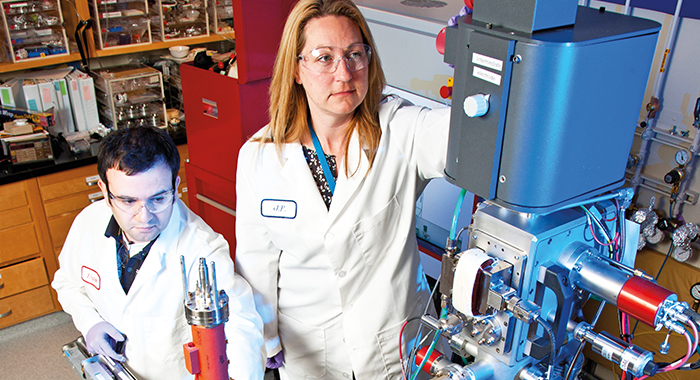Alumni Profile/To Infinity and Beyond
It’s a small number of people who can claim they’ve seen the depths of the earth as well as the outer reaches of space. Jenny (Piontek) Matzel ’95 is one of them.
Matzel (above, with colleague Ben Jacobsen), a researcher in the Nuclear & Chemical Sciences Division at the Lawrence Livermore National Laboratory, uses radioactive elements to determine the age of materials and trace their origins. From magma chambers to comet dust to nuclear fuel materials, her research is the common thread that ties the specializations together.
“I wouldn’t have predicted I would end up here,” she says. “But the research just kind of flowed from one thing to the next.”
While earning her Ph.D., Matzel researched magma chambers in Washington, using uranium and other radioactive elements to determine how those chambers formed. That research led her to post-doctoral work at the Berkeley Geochronology Center and then to Lawrence Livermore National Laboratory in California, where she worked on NASA’s Stardust space mission. Matzel studied dust particles from a comet and determined their ages.
“It was a pretty exciting mission. NASA hadn’t done sample-return missions in a long time. So, to have these particles back on Earth … it was really interesting,” she says.
In 2011, Matzel shifted her focus to nuclear materials. “It’s all in trying to understand the origin of materials,” she says. “In the early solar system, we’ve got processes of condensation and evaporation and irradiation from the sun, and some of those same types of processes are going on [in] a nuclear reactor.”
Matzel and her team of researchers focus on developing tools to help United States organizations like the International Atomic Energy Agency monitor nuclear facilities worldwide.
“I was one of the first group of geologists to graduate from St. Norbert,” she says. “All those tools and techniques I developed in my geology classes, applying those to new and different materials, that’s been really fun. … It’s been fun being able to apply that to magma chambers in the cascades of Washington state, and then go to looking at this cosmochemistry, this comet dust, and now applying those same things to nuclear materials to try and track their origins. It’s been really fun and exciting.”
June 30, 2018












